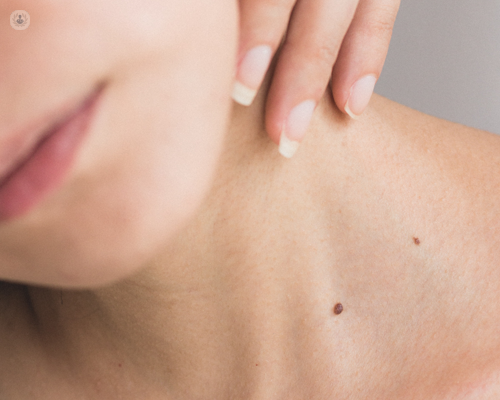Moles vs skin cancer: How to spot the difference and when to see a doctor
Written in association with:Moles, also known as nevi, are common skin growths that most people develop during their childhood or teenage years. They are typically brown or black and can appear anywhere on the skin. While moles are usually harmless, changes in their appearance or the development of new, unusual growths may be an early indication of skin cancer, particularly melanoma.
Melanoma is a serious form of skin cancer that arises when pigment-producing cells in the skin, called melanocytes, grow uncontrollably. Early detection and treatment of melanoma are critical to improving outcomes, so understanding the difference between benign moles and potentially cancerous growths is essential.

How can you spot the difference between moles and skin cancer?
To distinguish between normal moles and suspicious growths, dermatologists recommend using the ABCDE rule. This guideline helps identify warning signs that could indicate melanoma:
- A – Asymmetry: Benign moles are typically symmetrical, meaning that if you draw a line through the middle, both sides will match. A mole that is asymmetrical and irregularly shaped may be cause for concern.
- B – Border: Harmless moles have smooth, even borders. If a mole has a border that is ragged, notched or blurred, it could be a sign of skin cancer.
- C – Colour: Moles usually have a uniform colour, often a single shade of brown or black. If a mole contains multiple colours, or if it changes in colour over time, it should be checked by a doctor.
- D – Diameter: While non-cancerous moles are generally smaller, melanomas are often larger than 6mm (about the size of a pencil eraser). However, they can sometimes be smaller, so size alone should not be the only consideration.
- E – Evolving: One of the most important signs of skin cancer is change. If a mole starts to change in size, shape or colour, or if it develops new symptoms such as itching or bleeding, it’s important to have it evaluated by a doctor.
Other warning signs to look out for
Apart from the ABCDE rule, certain characteristics of moles and skin growths should prompt immediate medical attention:
- New moles: If you develop a new mole after the age of 25, it’s wise to monitor it closely and consult a dermatologist.
- Itching or tenderness: Moles that become itchy, painful or tender should be checked by a healthcare provider.
- Changes in texture: A mole that becomes scaly, crusty or starts to ooze or bleed could indicate skin cancer.
- Redness or swelling: When the area around a mole becomes red or swollen, this may be a sign that the mole is not benign.
When should you see a doctor?
It’s advisable to see a doctor if you notice any of the warning signs mentioned above. Regular self-examinations of your skin can help you detect changes early. Dermatologists often recommend scheduling an annual skin check-up, particularly if you have risk factors such as fair skin, a history of sunburns, numerous moles or a family history of skin cancer.
If a doctor is concerned about a mole, they may perform a dermoscopic examination to get a closer look or recommend a biopsy to determine if the mole is cancerous. Early diagnosis and prompt treatment are vital in managing melanoma effectively and preventing its spread.
What can you do to reduce your risk?
Preventative measures can lower your risk of developing melanoma and other skin cancers:
- Use sunscreen: Regular use of broad-spectrum sunscreen with an SPF of 30 or higher can help protect your skin from harmful UV rays.
- Avoid peak sun exposure: Try to stay out of the sun during peak hours (10 a.m. to 4 p.m.) when UV rays are the strongest.
- Wear protective clothing: Long-sleeved shirts, hats, and sunglasses can provide additional protection against sun exposure.
- Avoid tanning beds: UV radiation from tanning beds can increase your risk of developing skin cancer.
- Perform regular skin checks: Examine your skin monthly to monitor for any new or changing moles.
By understanding the signs of skin cancer and taking preventive steps, you can protect your skin health and reduce your risk of serious conditions like melanoma.


